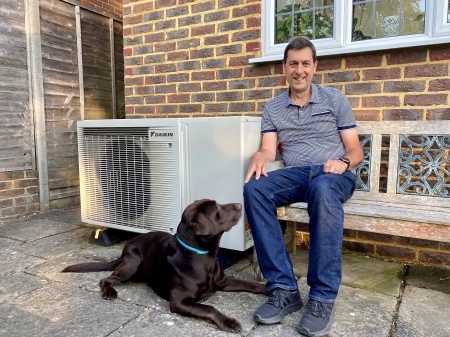
First time buyers’ energy guide
Are you in the process of buying your first home? Read on to get all the tips you need as a first-time buyer. Energy suppliers need to be told, and setting up gas and electricity in a new home is one of the first things you need to consider — but we've got you covered.
Owning your first home is super exciting – but moving can be stressful. So, we’ve put together handy first-time buyers’ tips for everything you need to know before you move into your first-ever home.
Before you move (if you’re currently renting)
- Let your energy supplier know that you're moving
- Read your meter on the day you move out and give these readings to your supplier. Read our guide to reading a meter
- Give your supplier a forwarding address so you can pay your final bill
After you move into your new home
- Find out who the new supplier is to let them know you’ve moved in. If you're not sure who your supplier is, Ofgem can help
- You can shop around for a better deal and change suppliers
- Read the meters on your first day and give these readings to your supplier
- Pay your final bill for your last property
First-time buyer energy bills
Setting up energy bills in a new home is one of the first things you should do, or you could find you're spending more money on gas and electricity than you need to.
When you move into your new home, the current energy supplier for the property will automatically transfer you to their standard tariff. This isn’t the best deal most of the time, so make sure you shop around to save more on your bill.
You could save more than you think by switching suppliers. Every household is unique and has different needs – so we have a range of tariffs that offer something different for everyone.
Electricity and gas quotes for first-time buyers are on top of everyone’s list – and finding the right deal can help you save cash. First-time buyers know that gas and electric bills are some of the biggest financial concerns, but you'd be surprised at the savings that can be made.
When moving house, utilities can have separate suppliers, so switching to dual fuel from a single company will save you money straight away.
First-time buyers’ checklist
How to set up gas and electricity for the first time in a new home
Setting up gas and electricity for the first time can be tricky. Here are our easy-to-follow steps for setting up gas and electricity in your home:
- Find out who supplies energy to the property
- Find your gas and electricity meters
- Take meter readings and contact the energy supplier
- Find the fuse box and trip switch
- Find your meter number
- Find out what tariff you’re on
- Find a better energy deal
Our full moving house checklist has all the details you need.
Find out who your energy supplier is
To help find out who your supplier is, you could ask the seller or estate agent (or developer if the property is a new build) before you move in.
Find your gas and electricity meters
These meters are usually in the kitchen, hallway, or outside – when you first view a house, note down where the meter is (the estate agent should be able to give you all the details).
Take meter readings and contact the energy supplier
Once you have moved in and you’ve found your meters, it’s important to take meter readings and submit them to the supplier. Otherwise, you may end up paying for energy you haven’t used. The supplier will give you all the help you need to set up gas and electricity for the first time.
Find the fuse box and trip switch
If your electricity is cut out, you need to know where your trip switch is to get everything back up and running. A trip is nothing to worry about – it’s usually a precaution to keep you safe if there is a faulty appliance.
You’ll find it in or near the fuse box, which will be just metres from the electricity meter.
Find your meter number (MPAN)
There are two types of meter numbers: Meter Point Administration Number (MPAN) for electricity and Meter Point Reference Number (MPRN) for gas.
The MPAN is unique to your home and is 21 digits long. It can be found on your bill and may also be called your “supply number”.
The MPRN is six to ten digits long and can also be found on your bill.
Find out what tariff you’re on
Once you know the energy supplier, it's best to find out what tariff you're on. The supplier will likely tell you what tariff you’re on. Switching can help you find a better deal.
Find a tariff to suit your needs
Moving into a new home provides a great opportunity to get an energy tariff that suits your needs. View our latest tariffs.
First-time buyer energy tips
As a first-time home buyer, you'll want to save money where possible. You can make savings by making simple changes or switches at home. Read our guide to making energy-efficient choices at home and read our top tips below to start new energy and money-saving habits from the start – for a minimal extra cost.
- Draught-proof any doors or windows with a cheap option like draught-excluding foam
- Take showers, not baths. Showers take much less energy than baths
- Keep windows shut in winter
- Turn down the thermostat a little bit on your boiler and room thermostat if you have one
- Replace your light bulbs with low-energy LED bulbs – they use much less energy and last much longer
Need more first-time homeowner tips?
Check out our other useful guides for homeowners:
- If you don't know dual fuel from Direct Debit, then our guide to energy tariffs is for you
- Boilers are a vital part of your home, so fixing common boiler problems is very important
- Our guide to keeping your home warm will help you feel cosy in cold weather
- Icy weather can mean frozen pipes - find out what to do and how to prevent them
Want to keep an eye on bills?
Smart meters allow you to easily monitor your energy usage – making adjustments to save where necessary. Sign up for a smart meter today.
Want more tips on keeping costs low?
There are lots of ways to keep energy use lower and bills down. Take a look at all of our tips to help you save at home. Get energy-saving tips.
Get a more suitable energy tariff
Property with a different supplier? No problem. With just three simple steps, you can switch to EDF.
New to EDF and moving home?
New to EDF and moving home?
Already with EDF?
Log into MyAccount to move home.
Related articles

Get shifty and reduce your carbon footprint

